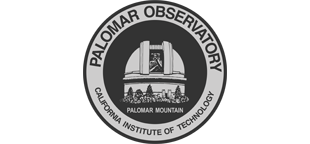
|
Celebrating 75 Years of Discovery
|

|
SWIFT Technical Specifications
View the original specs page.
The Oxford SWIFT spectrograph is an image-slicer based integral field spectrograph, that is coupled with the PALAO adaptive optics system on the Hale 200-inch telescope. The instrument comprises of a pre-optics, image slicer, and identical twin spectrographs, each consisting of a collimator, VPH grating, camera and an LBNL thick, fully depleted, 4k × 2k CCD array detector. There is also an internal calibration unit, with spectral calibration and flat fielding lamps.
- Pixel scales: 0.235″/pix, 0.16″/pix and 0.08″/pix, selectable on-the-fly.
- Field of view: 44 × 89 spaxels, corresponding to 10.3″ × 20.9″, 7.0″ × 14.2″, and 3.5″ × 7.1″ at the three spaxel scales.
- Wavelength range: 650 nm to 1000 nm, fixed format, in a single exposure.
- Spectral resolving power: R ≡ λ/Δλ = 3250 at 650 nm, rising linearly to 4400 at 1000 nm, 2 pixel spectral FWHM.
- Detector: Twin 4k × 2k LBNL thick, fully depleted CCD array detectors with enhanced red quantum efficiency and negligible fringing.
Expected Sensitivity
The following input parameters have been used to estimate the expected line and continuum sensitivity of the instrument. An exposure time calculator will shortly be available for detailed sensitivity calculations. In the meantime, expected performance can be scaled using the two examples provided below.
- Detector read noise: 5e− per pixel.
- Detector dark current: 8e− per hr per pixel.
- Instrument throughput: The most realistic estimate of the instrument throughput (excluding telescope, AO and detector) is given by the following table:
- Detector quantum efficiency: The LBNL thick (250 μm), fully-depleted CCD arrays provide unsurpassed QE at long wavelengths, providing SWIFT with a sensitivity gain of over a factor of three at long wavelengths, compared to normal CCDs. The detector QE at the operating temperature of 140K is given as:
- Telescope optics throughput: 0.75 (two Al reflections at 0.875 each).
- AO system science throughput: 0.8 (6 reflections at 0.98 (freshly recoated optics), plus one dichroic beamsplitter at 0.9).
- AO ensquared energy gain: factor of 1.6 gain in ensquared energy in the central pixel due to sharper core, no gain if extraction aperture is ≈ seeing disk size.
- Atmospheric transmission: assumed to be unity (detailed atmospheric transmission curve will be implemented in the ETC).
- Night sky background (average lunar illumination conditions): I band 19.5 mag/arcsec2, z band 18.3 mag/arcsec2.
- Detector exposure times (DIT): 30 minutes (1800 secs) per exposure, longer exposures are made up of NDIT sub-units DIT seconds long.
- Expected continuum sensitivity: For a z = 22 mag (Vega) point source, we obtain an SNR of 1.5 in the continuum (per spectral pixel) in a single 30 min exposure, in 1″ seeing.
- Expected line sensitivity: For a source with a line flux of 10−17 ergs s−1 cm−2 arcsec−2, with a line width of 150 km s-1, we obtain an SNR of 1 in the line a single 30 min exposure per spatial pixel. This corresponds to an SNR of 4 per 1″ extraction aperture in the same time.
| SWIFT Instrument Throughput | ||||||||
|---|---|---|---|---|---|---|---|---|
| Wavelength (nm) | 650 | 700 | 750 | 800 | 850 | 900 | 950 | 1000 |
| Transmission | 31.9% | 38.1% | 46.2% | 50.6% | 49.7% | 48.0% | 42.0% | 29.5% |
| SWIFT Detector Quantum Efficiency | ||||||||
|---|---|---|---|---|---|---|---|---|
| Wavelength (nm) | 650 | 700 | 750 | 800 | 850 | 900 | 950 | 1000 |
| Q.E. | 0.87 | 0.88 | 0.9 | 0.92 | 0.92 | 0.92 | 0.83 | 0.45 |
Operations
Operationally, we expect individual exposure times to be restricted to 1800 secs due to the number of cosmic ray events. As the LBNL chips have a thick (250 μm) silicon substrate, we are much more sensitive to cosmic ray events. Longer exposures will be made up of 1800 secs sub-units. If allowed by the source size, the rectangular field of view can be used to nod-on-IFU so that all the exposure time is spent observing the object.
Overheads: Apart from the overheads involved in achieving AO loop closure on the desired target, there should be only a few minute additional overhead for target acquisition and positioning within the field of view. SWIFT will provide an almost instantaneous reconstructed image to help with the acquisition. Detector read-out time is ≈ 40 seconds. SWIFT is equipped with a shutter to control short exposure times. The only configurable part in the instrument is the choice of spaxel scale, changes to which will need less than half a minute.
Questions? We've answered many common observing and operations questions in our observer FAQ page.
Please share your feedback on this page or any other Palomar topic at the
COO Feedback portal.
SWIFT Specs / v 2.0
Last updated: 16 June 2015 ACM
|
|
|